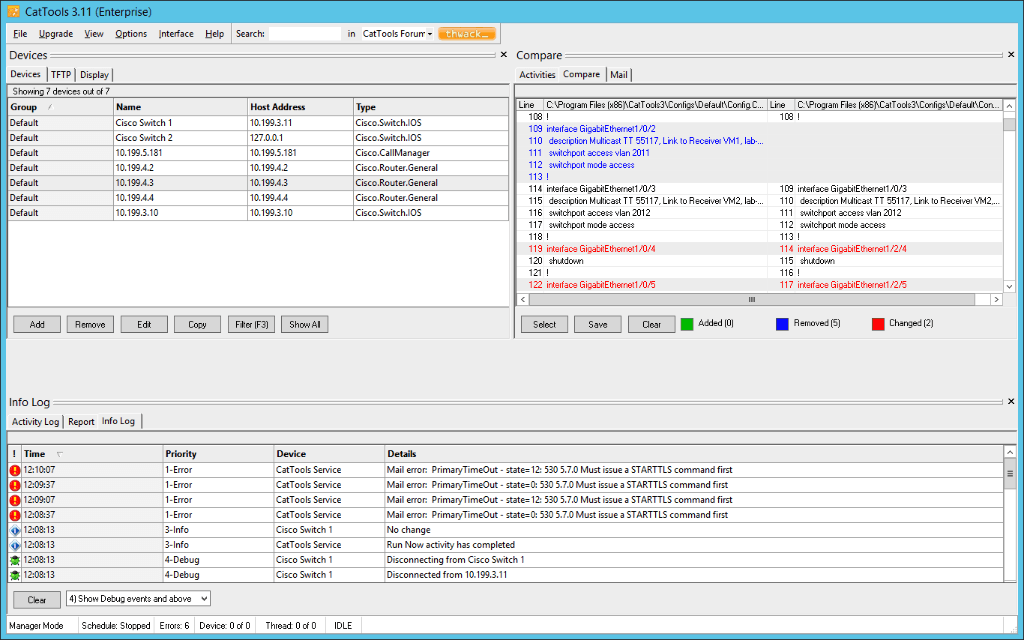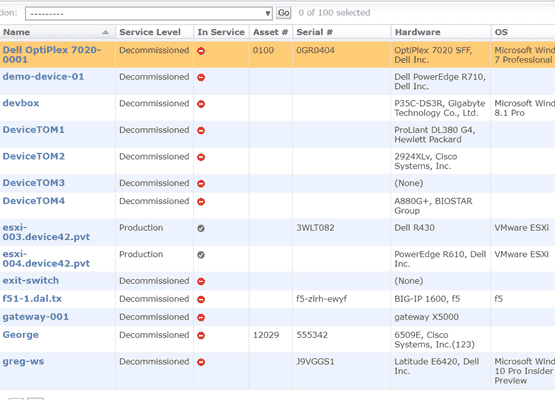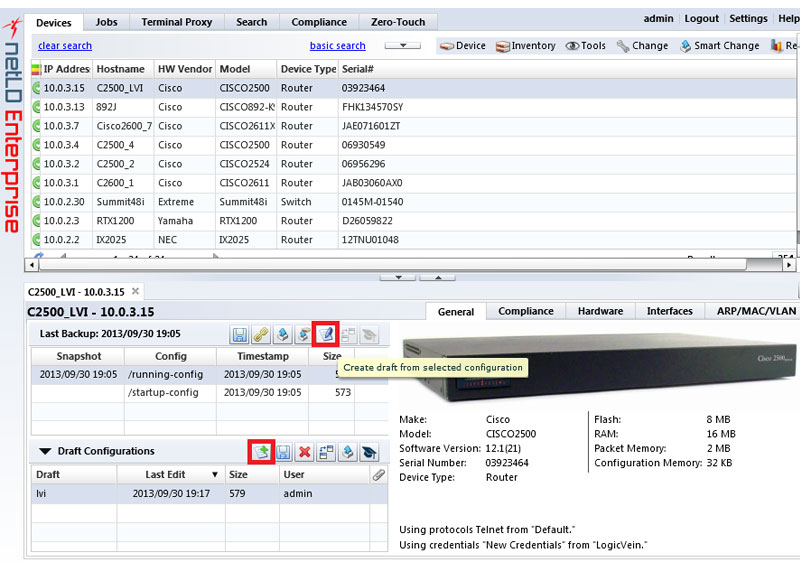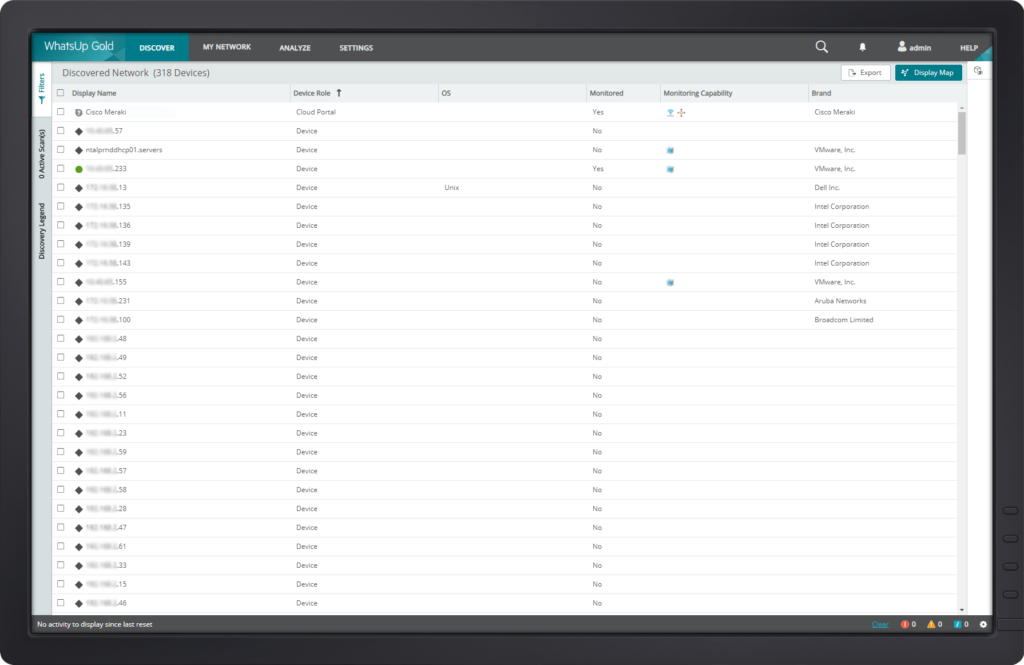Businesses both small and large require agility in how they handle device firmware and network configurations. For large networks especially, manual monitoring and change implementation can be inefficient. As such, more and more IT departments turn to automated network configuration management tools with bulk change capabilities.
With so many network configuration software options on the market, we’re sharing six of the best later in this article, with a solid recommendation for SolarWinds® Network Configuration Manager (NCM) and Kiwi CatTools for large enterprises and smaller businesses, respectively.
What Is Network Configuration?
How to Manage Network Configurations
Automated Configuration Management Benefits
Types of Network Configurations
How to Find and Check Network Configurations
Best Network Configurations Management Tools
- SolarWinds Network Configuration Manager (Top choice)
- Kiwi CatTools (Good option for smaller businesses)
- ManageEngine Network Configuration Manager
- Device42
- Netline LineDancer (NetLD)
- IPSwitch Configuration Management via WhatsUp Gold
Choosing the Right Network Configuration Software
What Is Network Configuration?
Before we dive into network configuration management, it’s important to understand the context behind network configuration.
In a nutshell, network configuration—also known as network setup—allows system administrators to assign settings, policies, and controls to devices on the network. This process also includes software installation and internet sharing.
Network configuration management also includes monitoring for configuration changes that could lead to security threats, system failures, or changes in operational flow. NCM software reduces the risk of these happening while making it easy to implement bulk changes across devices.
How to Manage Network Configurations
In the past, system administrators would manage network configurations manually by logging in to each device individually and changing settings one by one, but with the increased scope of technology, manual work seems impractical, especially since repetitive tasks done by hand creates room for errors.
Today, network admins can use automated tools to take the following actions as they manage network configurations:
- Distribute bulk updates to network devices or make individual, custom updates more easily
- Monitor devices for unauthorized configuration changes or security vulnerabilities
- Download device configuration files and store them in an archival system for potential rollbacks
- Audit configurations for compliance
- Restrict configuration permissions based on custom settings
Automated Configuration Management Benefits
Automation offers several advantages for configuration management. On the front end, network admins can use automation to set configurations in bulk, saving time and removing the risk of human error. It simplifies the ongoing configuration monitoring process by automatically recognizing multi-vendor device configurations, backing up and encrypting those configuration files, tracking and alerting on changes, and generating reports detailing inventory and compliance data. If errors occur, automation can help admins respond to errors more quickly and set an efficient action course for remediation.
Automating both simple and complex operations saves time and money in the long run as it helps minimize network downtime and removes the effort of individually managing numerous devices, all while automatically helping meet compliance with industry standards.
Types of Network Configurations
Configuration types may include device hardware or software settings, various policies (such as security policies), access and control settings, and setup related to flow. Configurations are needed for both cloud-based and on-premises networks to ensure security, compliance, and performance. Network configuration settings typically apply across routers, switches, firewalls, workstations, and similar devices.
How to Find and Check Network Configurations
It’s still possible to find and check configurations by hand. But because the process is so time-consuming, specialized software like SolarWinds NCM and Kiwi CatTools take out the hassle and instead provide a streamlined, automated method of checking configurations. These tools manage the console of each switch, monitor IP addresses, and check on port statuses of each device detected on the network, presenting all the information on a centralized dashboard.
Best Network Configuration Management Tools
1. SolarWinds Network Configuration Manager (Free Trial)
The top spot on our list goes to SolarWinds Network Configuration Manager (NCM). NCM comes with straightforward configurations out of the box, providing easy installation and immediate use. With fully automated configuration backup and restore points, multi-vendor capabilities, and an automated alert system, NCM sets itself as an industry-leading solution for mid-to-large businesses in need of bulk configurations. Its intuitive GUI-driven interface provides at-a-glance reporting, combining configuration management with network monitoring, so system administrators can have full, convenient control over network health and security.
The manager tool logs each device on the network, taking a snapshot of its configuration setting and storing it in an indexed, searchable archive, so in the future, manually locating a configuration file takes minimal effort. Additionally, updating, re-applying, or reversing those settings is easily accomplished with the automation feature. To reduce downtime, the tool can notify system administrators when a particular device—such as a switch, router, or firewall—is nearing the end of its lifecycle and needs replacing.
As mentioned earlier, automation and configuration management go hand-in-hand for maximum efficiency, and NCM does not disappoint. Through the intuitive dashboard, system administrators can set an automation schedule of bulk firmware updates, firewall rules, VLAN changes, and more.
The automation function even generates in-depth reports showing side-by-side comparisons of last known backups and current settings to ensure optimized performance.
System administrators leading team-based infrastructures will find NCM exceptionally helpful with its security option to restrict individual access based on settings. They can also activate a two-step verification process, so certain configuration reviews will require another administrator to confirm. In cases of unauthorized changes, the software will alert the system administrator, who can then review user activity logs and initiate any necessary reversals using the config restore points, a process as easy as selecting a device and a date from a drop-down list.
Managing a wide network of devices means increased risk of violating compliance regulations, but NCM’s automated scans generate reports that reveal breakdowns of policy violations and best practices for remediation, often with script recommendations for system administrators to launch for automatic redress.
In addition to a cloud-based deployment, SolarWinds NCM runs on Windows and SQL 2008 and up with a fully functional 30-day free trial offer.
2. Kiwi CatTools (Free Trial)
A simple yet powerful network automation and configuration management tool geared for small businesses, SolarWinds Kiwi CatTools combines affordability with effective device management. Key features include scheduling backups with a built-in Trivial File Transfer Protocol (TFTP) server, generating alerts and reports for configuration change management and analysis, and performing—or reversing—bulk configuration changes, all of which come with automated settings for maximum convenience.
Kiwi CatTools also creates both HTML and text-based basic configuration change reports related to port, MAC, ARP, and more, with the added option to email directly to key stakeholders.
Because the license cost of Kiwi CatTools depends on the number of devices it’s installed on, it gives much financial flexibility to small businesses who don’t necessarily need to run a large network. It also offers a 14-day free trial.
3. ManageEngine Network Configuration Manager
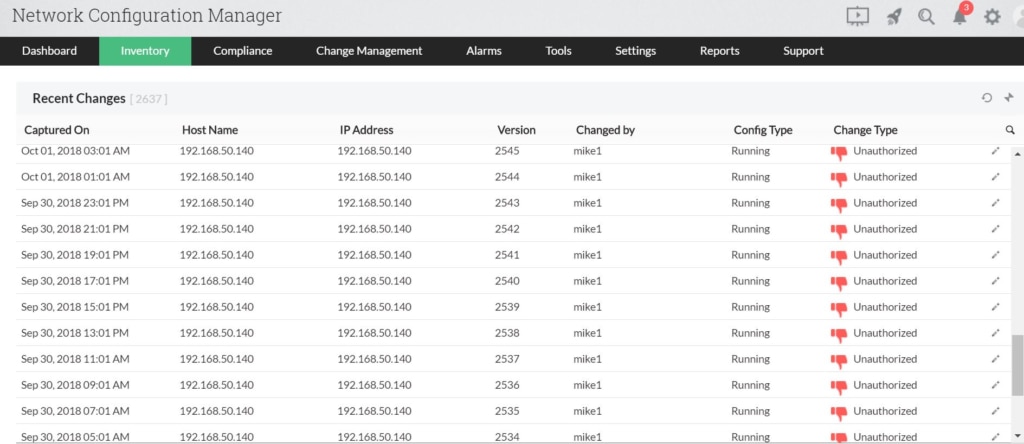
Ideal for large networks, ManageEngine immediately backs up all network configuration changes upon installation before running an automated sweep to analyze performance and monitor applications. This comprehensive network configuration software adapts to different user roles for a team-based infrastructure and easily handles multi-vendor networks while managing configurations for switches, firewalls, routers, and other detected devices on the system.
ManageEngine Network Configuration Manager also generates automated backups with easy-to-use config restore points, as well as reports detailing differences in configurations, which are especially useful when users need to reverse accidental or unauthorized changes. The configuration management system also keeps a log of user activity with the ability to suspend compromised accounts automatically. An additional helpful feature is the integrated patch manager, which enables managers to update all appropriate devices when software updates are available.
Compatible with both Windows and Linux systems, ManageEngine offers a 30-day free trial.
4. Device42
Suited for data centers or large managed service providers (MSPs), Device42 is a network configuration software that provides constant infrastructure monitoring and asset tracking with the added capability of adding new accounts for individual team members. Data centers will benefit from its multitude of features such as Data Room Layouts, Rack Diagrams, and Hardware Inventory Management. These tools provide remote visibility into the data centers and equipment availability, removing the need for complicated spreadsheets and in-person technician access.
To simplify data center network configuration management, Device42 combines management of assets and IP network address with data center infrastructure and configuration. Upon installation, the software logs device inventory—complete with settings and firmware versions—while performing configuration backups and continuous network sweeping to look for any changes and anomalies.
While Device42 offers cloud-based services, it is also available for on-premises installation on Windows and Mac OS with a 30-day free trial.
5. Netline LineDancer (NetLD)
Netline LineDancer—also known as NetLD—packs the standard features of network configuration management tools into a simple interface, making it ideal for smaller networks running up to 200,000 devices. It also lacks the access controls and patch management functions you’d find in some of the other network configuration tools geared for larger team-maintained complex systems, but for smaller scaled infrastructures, it gets the job done.
From the first scan, NetLD detects and logs all compatible devices by taking a snapshot of each configuration setting. This archive makes it easy to conduct full hardware inventory audits as well as implementation of bulk network configuration change. Detailed reports and automated processes allow users to monitor VLANS and VMs in addition to user activity to stay updated with changes across configurations.
Compatible with Linux, Windows, and CentOS, NetLD offers a 30-day free trial.
6. IPSwitch Configuration Management via WhatsUp Gold
A component of WhatsUp Gold, IPSwitch Configuration Management provides basic NCM tools for management, automation, and auditing as well as a robust monitoring and alerting system via email, text, web, and Slack for configuration changes and security/compliance failure.
Automated sweeps for configuration changes prevent negative effects from potential security risks and compliance infringement, and users can schedule backups and firmware updates with strategy guidance from side-by-side comparison charts. Bulk configuration changes for multiple devices means quick implementation that saves much time and money. Automatic network mapping detects new devices and automatically assigns them archived configuration settings, and any device that needs to be restored to a previous setting can do so without much downtime.
WhatsUp Gold IPSwitch Configuration Management runs on Windows and offers a 14-day free trial.
Choosing the Right Network Configuration Software
A few open-source network configuration management tools exist on the market, but as they only address basic configuration needs, we recommend looking into the six we’ve shared to harness the full power of automated configuration management. To determine the right software for your company, you should consider the size of your network (do you operate on a large multi-vendor network, or will a small business-oriented software work better for you?) as well as your budget. Fortunately, the six tools we’ve shared above all offer some form of free trial, so you can test out each product and discover which one works best to address your needs.
We believe SolarWinds NCM continues to hold the spot as the strongest contender, especially for large enterprises, because it offers a robust comprehensive solution and easily integrates with other SolarWinds products. Although it comes as an impressively large package of tools to support a wide network of vendors and devices, its out-of-the-box configuration proves easy to set up and get started. Additionally, its fully functional 30-day free trial provides ample time to properly grasp an understanding of its benefits. It’s also helpful to note SolarWinds runs a community forum of over 250,000 people who share and upload scripts, configurations, and settings.
Likewise, Kiwi CatTools stands out from the pack for smaller businesses by condensing the key features of powerful network configuration into a simple interface. Its automated features streamline manual workflows, and its ability to generate both HTML and text-based basic configuration change reports for stakeholders maximize visibility for everyone involved, all of which can be explored through its 14-day trial.
Whether you’re exploring options for a mid-to-large company or for a smaller outfit, these free trials will equip you with a thorough assessment to help you choose the right network configuration software.


